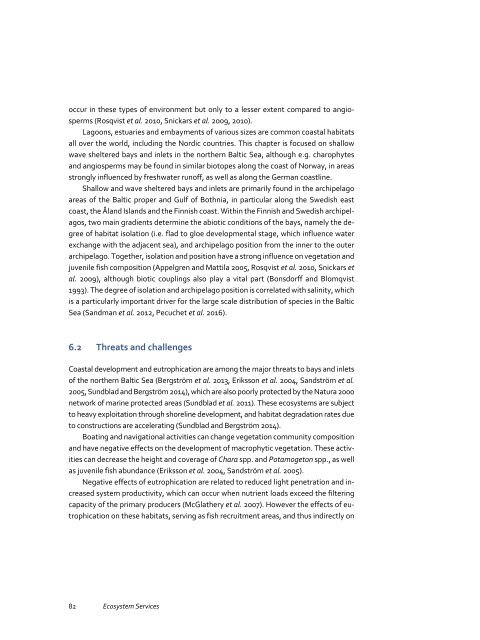Ecosystem Services
FULLTEXT01
FULLTEXT01
Create successful ePaper yourself
Turn your PDF publications into a flip-book with our unique Google optimized e-Paper software.
occur in these types of environment but only to a lesser extent compared to angiosperms<br />
(Rosqvist et al. 2010, Snickars et al. 2009, 2010).<br />
Lagoons, estuaries and embayments of various sizes are common coastal habitats<br />
all over the world, including the Nordic countries. This chapter is focused on shallow<br />
wave sheltered bays and inlets in the northern Baltic Sea, although e.g. charophytes<br />
and angiosperms may be found in similar biotopes along the coast of Norway, in areas<br />
strongly influenced by freshwater runoff, as well as along the German coastline.<br />
Shallow and wave sheltered bays and inlets are primarily found in the archipelago<br />
areas of the Baltic proper and Gulf of Bothnia, in particular along the Swedish east<br />
coast, the Åland Islands and the Finnish coast. Within the Finnish and Swedish archipelagos,<br />
two main gradients determine the abiotic conditions of the bays, namely the degree<br />
of habitat isolation (i.e. flad to gloe developmental stage, which influence water<br />
exchange with the adjacent sea), and archipelago position from the inner to the outer<br />
archipelago. Together, isolation and position have a strong influence on vegetation and<br />
juvenile fish composition (Appelgren and Mattila 2005, Rosqvist et al. 2010, Snickars et<br />
al. 2009), although biotic couplings also play a vital part (Bonsdorff and Blomqvist<br />
1993). The degree of isolation and archipelago position is correlated with salinity, which<br />
is a particularly important driver for the large scale distribution of species in the Baltic<br />
Sea (Sandman et al. 2012, Pecuchet et al. 2016).<br />
6.2 Threats and challenges<br />
Coastal development and eutrophication are among the major threats to bays and inlets<br />
of the northern Baltic Sea (Bergström et al. 2013, Eriksson et al. 2004, Sandström et al.<br />
2005, Sundblad and Bergström 2014), which are also poorly protected by the Natura 2000<br />
network of marine protected areas (Sundblad et al. 2011). These ecosystems are subject<br />
to heavy exploitation through shoreline development, and habitat degradation rates due<br />
to constructions are accelerating (Sundblad and Bergström 2014).<br />
Boating and navigational activities can change vegetation community composition<br />
and have negative effects on the development of macrophytic vegetation. These activities<br />
can decrease the height and coverage of Chara spp. and Potamogeton spp., as well<br />
as juvenile fish abundance (Eriksson et al. 2004, Sandström et al. 2005).<br />
Negative effects of eutrophication are related to reduced light penetration and increased<br />
system productivity, which can occur when nutrient loads exceed the filtering<br />
capacity of the primary producers (McGlathery et al. 2007). However the effects of eutrophication<br />
on these habitats, serving as fish recruitment areas, and thus indirectly on<br />
82 <strong>Ecosystem</strong> <strong>Services</strong>


